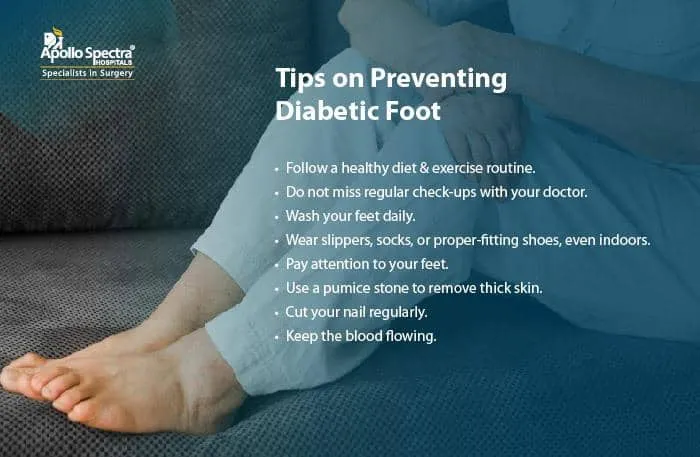Understanding the Risks, Symptoms, and Prevention for Diabetic Foot
June 30, 2023
Individuals with diabetes must pay special attention to their health because diabetes can lead to several other health complications. From heart disease to chronic kidney disease and nerve damage, managing diabetes is important to live a healthy life.
Besides certain complications, diabetic foot problems are common among people with high sugar levels. However, with the help of expert doctors, like Apollo Foot and Ankle Clinic in Chennai, you don't have to worry about your health because we got you!
This blog explains everything about diabetic feet and prevention tips for staying fit!
Risks, Symptoms, and Prevention for Diabetic Foot
How is Diabetes Related to Foot Health?
The body's neurological system suffers when a patient has high blood sugar levels for a long time. This long-term nerve damage is called diabetic neuropathy.
Besides nerve damage, high sugar levels affect the blood vessels of the feet. There is poor blood flow, which often causes cell death. As multiple cells die in the foot at a premature age, it may result in gangrene.
Furthermore, delayed healing can make things more complicated. It is because the wound healing will take a little longer than normal. So, a small wound or ulcer that goes undetected or untreated can lead to diabetic foot ulcers.
In some cases, if the gangrene or foot ulcers do not get better with medications, the doctor may have to amputate the feet to avoid the infection from spreading.
Risks and Factors Contributing to Diabetic Foot
Here are a few risks and factors that contribute to diabetic feet that you must know of:
- Peripheral artery disease
- History of varicose veins
- Repeated corns and calluses in their foot
- Improper diet and poor exercise regime
- High sugar levels all the time
- People with age over 40
Symptoms of Diabetic Foot
With the advancements in medical science and technology, it is easy to treat diabetic feet and reduce complications if it is diagnosed in the early stage. Here are some symptoms of diabetic feet:
- Pain in your legs, buttocks, thighs, or calves
- Tingling, burning, or pain in your feet
- Loss of feeling in your feet
- Change in the shape of your feet with time
- Dry and cracked skin on feet
- Change in color and temperature of your feet
- Thick and yellow toenails
- Fungal infection
- A blister, sore, ulcer, or an ingrown toenail
Signs You Need Medical Help
If you have symptoms that are consistent with diabetic foot and are wondering if you should visit the doctor, here are some signs:
- A persistent bluish-black discoloration could be an indication of active necrosis.
- An unpleasant scent could indicate the presence of gangrene.
- It could be a symptom of an active illness if the skin's temperature changes and feels warmer.
- If you have open sores or ulcers that last longer than a week.
- If you have constant pain in your leg with a throbbing sensation.
- If you have dry cracks on the sole of your foot, especially in the region of the heels.
Tips on Preventing Diabetic Foot
Managing diabetes can help you avoid several associated complications, even if you are old. It is essential to remember that diabetes increases with a high intake of foods with glucose. So, reduce the portion of food with glucose from your diet.
Here are some additional tips that you can include in your daily routine to prevent diabetic feet:
- Follow a healthy diet and exercise routine.
Follow and maintain a healthy routine, including a regular workout and exercise. It shall help ensure a constant blood flow in your feet.
- Do not miss regular check-ups with your doctor.
Ensure to monitor your blood sugar levels. Visit your doctor for a check-up as per the schedule.
- Wash your feet daily.
Use warm water and mild soap to clean your feet daily. Dry your feet, and you can use talcum powder to soak up water. However, if you use a lotion, avoid using it between your toes.
- Wear slippers, socks, or proper-fitting shoes, even indoors.
Avoid walking or running with bare feet, even indoors. Always wear proper-fitting shoes, socks, or slippers, to protect your feet.
- Pay attention to your feet.
Inspect your feet daily and visit your doctor if any signs or symptoms seem concerning.
- Use a pumice stone to remove thick skin.
If you have corns and calluses, smoothen them with a pumice stone.
- Cut your nail regularly.
Personal hygiene can help prevent ingrown nails and the accumulation of bacteria. Cutting and trimming nails can help in reducing the chances of infection.
- Keep the blood flowing.
Keep your feet up while sitting, and frequently wiggle your toes and circle your feet. Moreover, avoid wearing tight socks.
Wrapping up,
If you have diabetes, you must be highly cautious about your body and blood sugar levels. You have a high chance of developing diabetic feet if you have increased diabetic levels. With proper care and regular check-up, you can avoid complications like diabetic foot ulcers.
Experts doctors at Apollo Foot and Ankle Clinic will provide an effective plan and diet to avoid diabetic feet. Visit our website and schedule an appointment with our experts if anything concerns you!
Here are the symptoms: Tingling, burning sensation in feet Loss of feeling, like no hot and cold sensation Blister, sore, ulcer, or ingrown toenail
In the extreme phase of diabetic foot ulcers, surgery is required to avoid spreading the infection to the other parts.
Here are some signs: Infection that becomes black and smells Red, warm, and painful skin Callus with dried blood inside A cut, blister, or bruise that doesn't heal in a few days.
NOTICE BOARD
CONTACT US
CONTACT US
 Book Appointment
Book Appointment


.svg)
.svg)
.svg)
.svg)








